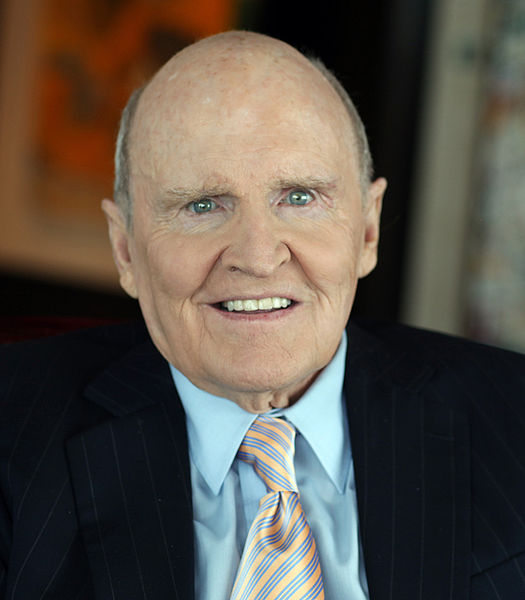Unleashing Excellence: The Leadership Legacy of Jack Welch

Embarking on a Transformational Journey: Lessons from Jack Welch’s Leadership
Jack Welch’s influential career and his impact on the field of leadership
Jack Welch, a legendary figure in the realm of leadership, is widely recognized for his transformative tenure as the CEO of General Electric (GE) from 1981 to 2001. Welch’s innovative strategies and relentless pursuit of excellence earned him the reputation of being one of the most successful corporate leaders of his time. His leadership philosophy, often referred to as the “Welch Way,” has left an indelible mark on the business world and continues to inspire aspiring leaders around the globe.
Importance of studying Jack Welch’s leadership approach and the lessons it offers
Examining the leadership approach of Jack Welch is of paramount importance due to the lasting impact he had on GE’s performance and culture. Under Welch’s guidance, GE’s market value skyrocketed from $13 billion to over $400 billion, making it the most valuable company in the world at the time. Moreover, Welch’s leadership principles have stood the test of time, proving their efficacy in diverse industries and organizational contexts.
By delving into Welch’s leadership journey and dissecting his strategies, we can uncover invaluable insights that can be applied to our own leadership endeavors. Welch’s experiences serve as a treasure trove of lessons, shedding light on various aspects of effective leadership, including strategic vision, talent management, cultural transformation, and embracing change. As we explore the principles and stories that defined Welch’s leadership, we gain a deeper understanding of what it takes to drive success and create a lasting impact as a leader.
Early Life and Career of Jack Welch
Background information on Jack Welch’s upbringing and education
Jack Welch’s formative years played a crucial role in shaping his leadership style and approach. Growing up in a modest neighborhood in Peabody, Massachusetts, Welch learned the value of hard work and resilience from his parents. His father, a railroad conductor, and his mother, a homemaker, instilled in him a strong work ethic and a sense of discipline.
Welch’s pursuit of education began at the University of Massachusetts Amherst, where he earned a Bachelor of Science degree in chemical engineering in 1957. It was during his time at university that Welch demonstrated his natural ability to lead and inspire others. He served as the president of his fraternity and showed exceptional organizational and communication skills.
Notable milestones and experiences that shaped his leadership style
After completing his undergraduate studies, Welch continued his education at the University of Illinois Urbana-Champaign, where he earned his Ph.D. in chemical engineering in 1960. This academic journey provided him with a strong foundation in analytical thinking and problem-solving, skills that would later prove invaluable in his leadership role at GE.
Welch’s professional career took off when he joined General Electric in 1960 as a chemical engineer in the Plastics division. Through hard work and determination, he quickly rose through the ranks, taking on various managerial roles in different divisions of the company. These early experiences at GE exposed Welch to the complexities of managing diverse teams and navigating organizational dynamics.
One of the key milestones in Welch’s career was his appointment as the CEO of General Electric in 1981. At the time, GE was facing numerous challenges, including a rigid bureaucracy, slow decision-making processes, and declining profitability. Welch embarked on a mission to revitalize the company and transform it into a lean, agile, and high-performing organization.
Introduction to his tenure as the CEO of General Electric (GE)
Welch’s tenure as the CEO of GE marked a turning point not only for the company but also for the field of leadership. Over the course of his 20-year leadership, Welch implemented a series of bold and innovative strategies that catapulted GE to new heights of success.
Welch’s leadership approach at GE was characterized by a relentless focus on performance and accountability. He instituted a system known as “rank and yank,” where employees were evaluated on their performance and the bottom 10% were let go each year. This approach, although controversial, created a culture of meritocracy and pushed employees to continually strive for excellence.
Another significant initiative introduced by Welch was the adoption of Six Sigma methodologies across the organization. Six Sigma aimed to reduce defects and improve quality by employing rigorous statistical analysis and process improvement techniques. This focus on quality excellence became synonymous with GE under Welch’s leadership and contributed to its reputation as an industry leader.
Welch also prioritized strategic acquisitions and diversification during his tenure. He led GE’s expansion into new industries, such as finance and media, through bold acquisitions, including the purchase of RCA and NBC. These strategic moves not only broadened GE’s portfolio but also positioned the company as a global conglomerate with a diverse range of business interests.
Through his visionary leadership, Welch transformed GE’s corporate culture, creating an environment that valued innovation, agility, and continuous improvement. His initiatives, combined with his charismatic and hands-on leadership style, earned him the nickname “Neutron Jack” for his ability to eliminate inefficiencies while leaving the infrastructure intact.
Welch’s tenure at GE came to an end in 2001, but his impact on the company and the field of leadership remains profound. His legacy continues to serve as a source of inspiration for leaders seeking to drive change, build high-performing teams, and achieve sustainable success. The leadership principles and strategies implemented by Welch, such as setting clear visions, fostering a culture of accountability, and embracing change, are timeless and can be adapted to various industries and organizational contexts. Today, leaders can draw valuable insights from Welch’s transformative journey at GE, applying his lessons to navigate the complexities of the modern business landscape. The enduring legacy of Jack Welch lies in his ability to challenge the status quo, inspire excellence, and leave a lasting impact on the art and practice of leadership.
Setting the Stage for Transformation
Examination of the challenges faced by GE before Jack Welch’s leadership
Prior to Jack Welch’s ascent to the position of CEO, General Electric faced a multitude of challenges that threatened its long-term viability. The company had become bloated and bureaucratic, with complex hierarchies and slow decision-making processes. Inefficiencies were rampant, stifling innovation and hindering the company’s ability to adapt to a rapidly changing business landscape. Moreover, GE’s financial performance was lackluster, and it faced intense competition from both domestic and international rivals.
Welch’s visionary strategy and bold initiatives to transform GE’s culture and performance
Recognizing the need for a radical transformation, Jack Welch embarked on a bold and ambitious journey to revitalize GE. Central to his strategy was the concept of “boundarylessness,” which aimed to break down silos, foster collaboration, and encourage the free flow of ideas and information throughout the organization. Welch believed that by eradicating barriers and encouraging cross-functional collaboration, GE could harness its collective intelligence and drive innovation.
Welch also emphasized the importance of differentiation and focusing on areas where GE could be a market leader. He implemented a strategy known as “Fix, Sell, or Close,” where underperforming businesses were either improved, divested, or discontinued. This ruthless approach ensured that resources were allocated to the most promising and profitable ventures, enabling GE to concentrate its efforts and resources where it had a competitive advantage.
Furthermore, Welch recognized the significance of human capital in driving organizational success. He placed a strong emphasis on talent management, implementing a rigorous performance evaluation system and actively promoting a culture of meritocracy. Welch believed in nurturing and rewarding high performers while holding everyone accountable for results. This approach fueled a sense of healthy competition and motivated employees to continuously strive for excellence.
Welch was also a staunch advocate for change and innovation. He understood that in a rapidly evolving business landscape, standing still meant falling behind. He encouraged a culture of experimentation and risk-taking, recognizing that failure was an inherent part of the innovation process. Welch encouraged his employees to challenge the status quo, experiment with new ideas, and embrace calculated risks, fostering a culture of continuous improvement and adaptation.
In addition, Welch placed significant emphasis on effective communication and transparency. He recognized that open and honest communication was vital for building trust, aligning goals, and driving organizational change. Welch himself was known for his charismatic and engaging communication style, often delivering candid and straightforward messages to employees, shareholders, and the wider business community.
Through these visionary strategies and bold initiatives, Jack Welch orchestrated a profound transformation within GE. His relentless pursuit of operational excellence, coupled with a culture of innovation and a focus on talent, propelled the company to unprecedented levels of success and positioned it as a global powerhouse.
Leadership Principles and Strategies of Jack Welch
The importance of setting a clear vision and strategy
One of the fundamental leadership principles espoused by Jack Welch was the significance of setting a clear vision and strategy for the organization. Welch believed that leaders must have a compelling vision that inspires and aligns their teams. A clear vision serves as a guiding star, providing direction and purpose, and rallying employees around a common goal. Welch’s vision for GE was to create a dynamic and boundaryless organization that constantly outperformed its competition.
In addition to a compelling vision, Welch emphasized the need for a well-defined and actionable strategy. He believed that strategy should be focused, concise, and easily communicable. Welch famously implemented the “number one or number two” rule, which meant that GE should strive to be either the market leader or a strong contender in every industry it operated in. This strategy required GE to make strategic choices, allocate resources wisely, and relentlessly pursue excellence in chosen areas of focus.
Building a winning team: Attracting, developing, and retaining top talent
Another key pillar of Welch’s leadership philosophy was the relentless pursuit of talent. He recognized that the success of an organization hinges on its people, and thus, attracting, developing, and retaining top talent became a critical priority. Welch believed in building a winning team by surrounding himself with the best and the brightest.
To attract top talent, Welch emphasized the importance of fostering a culture of meritocracy, where performance and results were rewarded. He instituted a rigorous performance evaluation system, known as the “vitality curve” or “forced ranking,” which involved categorizing employees into different performance tiers. High performers were identified and rewarded, while underperformers were given opportunities to improve or were ultimately let go. This approach not only motivated employees to strive for excellence but also created a culture of accountability and high performance.
Welch also emphasized the importance of developing talent from within the organization. He believed in nurturing and empowering employees, providing them with opportunities for growth and advancement. Welch encouraged a culture of continuous learning and development, offering various training programs and educational initiatives to enhance the skills and capabilities of GE’s workforce. By investing in the development of employees, Welch not only built a pipeline of future leaders but also fostered a sense of loyalty and commitment among the workforce.
The value of creating a performance-driven culture
Central to Welch’s leadership approach was the creation of a performance-driven culture. He believed that to achieve sustained success, organizations must prioritize performance and reward those who deliver exceptional results. Welch’s philosophy was encapsulated in his famous quote, “There’s no such thing as work-life balance. There are work-life choices, and you make them, and they have consequences.”
Welch believed in setting ambitious goals and challenging his teams to exceed expectations. He encouraged a culture of continuous improvement, urging employees to identify inefficiencies, streamline processes, and eliminate bureaucracy. Welch’s relentless focus on performance permeated every aspect of GE’s operations, from operations and manufacturing to marketing and sales.
Welch also believed in creating a culture of candor and constructive feedback. He encouraged open and honest communication, even when it involved difficult conversations. Welch believed that fostering an environment where employees felt safe to voice their opinions and challenge the status quo was essential for driving innovation and pushing the boundaries of performance.
Embracing change and fostering innovation
Welch recognized that in a rapidly evolving business landscape, organizations must be agile and adaptable to remain competitive. He understood that change was not only inevitable but also essential for growth and success. Welch famously said, “Change before you have to.”
Welch actively promoted a culture of innovation, encouraging employees at all levels to generate new ideas and embrace calculated risks. He believed in continuously pushing the boundaries of what was possible and challenging the status quo. Welch championed a philosophy of “boundarylessness,” encouraging employees to break down silos, collaborate across functions, and explore new opportunities.
To foster innovation, Welch implemented various initiatives at GE. He established programs like “Work-Out” and “Best Practices” that encouraged employees to identify inefficiencies, propose solutions, and share best practices across the organization. Welch believed that by creating a culture of open dialogue and empowering employees to contribute their ideas, GE could drive continuous improvement and stay ahead of the competition.
Furthermore, Welch recognized the importance of embracing external innovation. He actively sought out partnerships and collaborations with external organizations, universities, and research institutions to tap into emerging technologies and ideas. Welch understood that staying at the forefront of innovation required not only internal ingenuity but also a willingness to learn from external sources and adapt to market trends.
Welch’s views on effective communication and transparency
Effective communication was a hallmark of Jack Welch’s leadership style. He understood the critical role that communication played in aligning teams, inspiring action, and driving change. Welch believed in the power of clear and concise messaging, avoiding jargon and complex language to ensure that his ideas were understood by everyone in the organization.
Welch actively sought opportunities to communicate with employees, shareholders, and the wider business community. He believed in being accessible and approachable, frequently engaging in town hall meetings, conducting site visits, and encouraging direct interaction with employees at all levels. Welch’s charismatic and engaging communication style allowed him to convey his vision, rally support, and inspire commitment.
Transparency was another key aspect of Welch’s leadership philosophy. He believed in sharing information openly, even when it was difficult or uncomfortable. Welch recognized that transparency built trust and credibility among stakeholders and helped foster an environment of accountability. By providing regular updates on the company’s performance and challenges, Welch ensured that employees were well-informed and could align their efforts accordingly.
Welch’s commitment to effective communication and transparency extended beyond internal stakeholders. He recognized the importance of communicating with external audiences, including shareholders, customers, and the media. Welch believed in the power of storytelling to convey GE’s vision, values, and achievements. His ability to articulate a compelling narrative about GE’s journey and successes helped shape the external perception of the company and garnered support from various stakeholders.
Jack Welch’s leadership principles and strategies were anchored in a clear vision, a focus on building winning teams, creating a performance-driven culture, embracing change and fostering innovation, and effective communication and transparency. Through his visionary leadership at GE, Welch demonstrated the transformative power of these principles, taking a struggling conglomerate and turning it into a global powerhouse. The enduring legacy of Jack Welch lies not only in the remarkable success he achieved at GE but also in the invaluable lessons his leadership journey provides for aspiring leaders across industries.
Stories of Success: Real-World Examples
Case study 1: Revitalizing GE’s global operations
One of the remarkable achievements during Jack Welch’s leadership was the revitalization of GE’s global operations. When Welch assumed the role of CEO, GE’s international presence was relatively limited. Recognizing the opportunities in global markets, Welch embarked on an aggressive expansion strategy, acquiring companies and establishing a strong presence in key markets worldwide.
Welch understood the importance of adapting GE’s operations to local markets while maintaining a global mindset. He encouraged decentralization and empowered local leaders to make decisions tailored to their specific markets. This approach allowed GE to gain deeper insights into local customer needs, adapt products and services accordingly, and establish strong relationships with local partners.
Welch’s strategic moves and emphasis on globalization transformed GE into a truly global enterprise. Under his leadership, GE expanded into emerging markets, such as China and India, capturing new growth opportunities. This global expansion not only diversified GE’s revenue streams but also positioned the company as a leader in multiple industries across the globe.
Case study 2: Implementing Six Sigma and the pursuit of quality excellence
Another notable success story of Welch’s leadership was his implementation of Six Sigma methodologies at GE. Six Sigma is a data-driven approach that aims to minimize defects and variations in processes, resulting in improved quality and operational efficiency. Welch recognized the potential of Six Sigma to drive significant improvements in performance and customer satisfaction.
Welch championed the adoption of Six Sigma throughout the organization, making it a core part of GE’s culture. He established rigorous training programs to develop a large pool of Six Sigma experts, known as Black Belts and Green Belts, who were responsible for leading process improvement projects across GE’s businesses.
The impact of Six Sigma on GE’s performance was profound. Welch set a goal of achieving a Six Sigma level of quality, which equates to no more than 3.4 defects per million opportunities. By reducing defects and streamlining processes, GE realized significant cost savings, improved customer satisfaction, and enhanced operational efficiency.
The successful implementation of Six Sigma at GE became a benchmark for quality excellence in the business world. Welch’s commitment to a data-driven approach and relentless pursuit of process improvement set a new standard for performance excellence and inspired numerous organizations to adopt similar methodologies.
Case study 3: Acquisition strategy and diversification of GE’s portfolio
Jack Welch’s strategic approach to acquisitions played a crucial role in the transformation of GE. Welch recognized that in order to sustain growth and maintain a competitive edge, GE needed to expand its portfolio and diversify into new industries.
Welch pursued an aggressive acquisition strategy, targeting companies that aligned with GE’s core competencies and offered opportunities for synergy. One of the most significant acquisitions under Welch’s leadership was the purchase of RCA, which included the iconic NBC television network. This strategic move allowed GE to enter the media industry, diversifying its revenue streams and expanding its influence in the entertainment sector.
Welch also led GE’s foray into financial services through the acquisition of companies like Kidder Peabody and Employers Reinsurance Corporation (ERC). This expansion into the financial sector provided GE with additional avenues for growth and profitability.
The success of Welch’s acquisition strategy can be attributed to his rigorous evaluation process and emphasis on integration. Welch ensured that acquired companies were aligned with GE’s culture, values, and performance expectations. He focused on extracting synergies, leveraging GE’s expertise, and integrating acquired businesses seamlessly into the GE family.
Through strategic acquisitions and diversification, Welch transformed GE from a predominantly industrial company into a diversified conglomerate, expanding its presence in sectors such as aviation, healthcare, energy, and finance. This diversification not only reduced GE’s exposure to industry volatility but also positioned the company to capitalize on emerging opportunities in various sectors.
Welch’s ability to identify strategic acquisition targets and successfully integrate them into GE’s operations demonstrated his astute business acumen and his vision for creating a robust and resilient organization.
These real-world examples of success under Jack Welch’s leadership highlight his strategic thinking, innovative mindset, and relentless pursuit of excellence. Whether through global expansion, implementing Six Sigma, or strategic acquisitions, Welch demonstrated a keen understanding of how to drive growth, improve operational efficiency, and create value for shareholders.
These stories of success serve as powerful illustrations of the principles and strategies that underpinned Welch’s leadership approach. They showcase his ability to envision new possibilities, take calculated risks, and execute bold strategies that resulted in tangible business outcomes. Welch’s stories inspire leaders to think beyond traditional boundaries, challenge the status quo, and embrace innovative approaches to drive success in their own organizations.
Beyond the tangible achievements, these stories also shed light on Welch’s leadership style and the impact it had on GE’s culture. Welch’s emphasis on accountability, performance excellence, and fostering a culture of continuous improvement set a new standard for organizational behavior. His hands-on approach, transparent communication, and ability to inspire and motivate teams played a pivotal role in driving the successful execution of his strategies.
Welch’s leadership stories serve as a valuable source of inspiration and learning for leaders across industries. They demonstrate the power of visionary thinking, strategic decision-making, talent development, embracing change, and effective communication. Welch’s experiences provide a blueprint for leaders aspiring to achieve transformational success in their organizations, reminding them of the importance of boldness, agility, and a relentless focus on delivering results.
By studying and internalizing the lessons embedded in these stories, leaders can gain insights into the mindset and practices that enabled Welch to achieve remarkable success at GE. They can apply these lessons to their own leadership journeys, adapting and tailoring them to their specific organizational contexts, and driving their teams and organizations towards excellence.
In the next section, we will explore the challenges and controversies that emerged during Jack Welch’s tenure as CEO of General Electric, providing a balanced perspective on his leadership legacy.
Challenges and Controversies
Discussion of criticism and controversies surrounding Jack Welch’s leadership approach
While Jack Welch’s leadership at General Electric was widely celebrated, it was not without its fair share of criticism and controversies. Some of the key criticisms leveled against Welch include his aggressive cost-cutting measures, the impact of his forced ranking system, and the focus on short-term financial results at the expense of long-term sustainability.
Welch’s approach to cost-cutting, often referred to as “Neutron Jack” or “Chainsaw Al,” involved significant layoffs and downsizing to streamline operations and improve efficiency. Critics argue that this approach, while effective in boosting short-term profitability, may have had negative consequences for employee morale, job security, and long-term organizational health.
The forced ranking system implemented by Welch, known as “rank and yank” or the “vitality curve,” also generated controversy. This system required managers to rank employees into different performance tiers, resulting in the termination of a fixed percentage of employees each year. Critics argue that this approach fostered a cutthroat and competitive environment, stifling collaboration and discouraging risk-taking.
Additionally, some have criticized Welch’s focus on short-term financial results, suggesting that it may have come at the expense of long-term investments in research and development and innovation. Welch’s relentless pursuit of quarterly earnings targets and his emphasis on meeting or exceeding Wall Street’s expectations led to concerns that the long-term health and sustainability of the organization were compromised.
Analyzing the potential downsides and unintended consequences of certain strategies
It is essential to critically analyze the potential downsides and unintended consequences of Jack Welch’s strategies to gain a balanced perspective on his leadership approach. While his cost-cutting measures and emphasis on performance were successful in improving GE’s profitability, there were negative consequences that emerged.
The aggressive cost-cutting initiatives, while necessary to streamline operations, may have had adverse effects on employee morale and organizational culture. Layoffs and downsizing can create an atmosphere of fear and uncertainty, leading to decreased employee engagement, increased turnover, and a loss of institutional knowledge. Furthermore, the forced ranking system may have created a hyper-competitive environment that discouraged collaboration and innovation, potentially hindering long-term growth and stifling creativity.
The focus on short-term financial results may have also come at the expense of long-term investments in research and development (R&D) and innovation. By prioritizing short-term profitability and meeting quarterly targets, there is a risk of neglecting investment in future technologies, new product development, and market exploration. This trade-off could impact the organization’s ability to stay ahead of disruptive market forces and maintain a sustainable competitive advantage in the long run.
Lessons to be learned from the challenges faced by Welch and GE
The challenges and controversies surrounding Welch’s leadership offer valuable lessons for leaders in navigating complex organizational dynamics and striking a balance between short-term results and long-term sustainability.
-
Consider the human impact: While cost-cutting measures may be necessary in certain circumstances, leaders must carefully consider the human impact of such actions. Balancing financial objectives with employee well-being, communication, and transparency can help mitigate the negative effects on morale and organizational culture.
-
Foster collaboration and innovation: While performance-based rankings can provide valuable feedback, it is crucial to foster a culture that encourages collaboration, creativity, and risk-taking. Building teams that work together towards common goals and promoting an environment where diverse perspectives are valued can drive innovation and sustained success.
-
Balance short-term results with long-term investments: Leaders should strike a balance between meeting short-term financial objectives and investing in long-term growth and innovation. Allocating resources to research and development, talent development, and strategic initiatives is essential for maintaining a competitive advantage and ensuring long-term sustainability. Leaders must resist the pressure of solely focusing on quarterly earnings and communicate the importance of balancing short-term results with long-term strategic investments.
-
Foster a culture of adaptability and learning: The business landscape is constantly evolving, and leaders must embrace change and promote a culture of adaptability. This involves encouraging continuous learning, embracing new technologies and market trends, and empowering employees to contribute innovative ideas. By cultivating a culture of agility and openness to change, organizations can navigate disruptions and maintain their competitive edge.
-
Take a holistic view of performance: While financial metrics are important, leaders should take a holistic view of performance that includes factors beyond short-term profits. This includes considerations such as employee satisfaction, customer loyalty, and corporate social responsibility. By broadening the definition of success, leaders can foster a more sustainable and balanced approach to organizational performance.
Reflecting on the challenges and controversies faced by Jack Welch and General Electric allows leaders to glean valuable insights into the complexities of leadership and the potential trade-offs that come with implementing transformative strategies. It highlights the need for leaders to carefully evaluate the impact of their decisions on various stakeholders, maintain a long-term perspective, and continuously adapt their approach to align with evolving market dynamics and societal expectations.
By learning from both the successes and the challenges, leaders can refine their own leadership philosophies, adopt a more nuanced approach, and apply the lessons learned to create organizations that are not only financially successful but also foster a culture of collaboration, innovation, and sustainable growth.
In the following section, we will explore the enduring legacy of Jack Welch and the lasting impact of his leadership principles on subsequent generations of leaders.
Legacy and Lasting Impact
Evaluation of Jack Welch’s long-term impact on GE and the business world
Jack Welch’s legacy as a transformative leader extends far beyond his tenure as the CEO of General Electric. His impact on GE and the business world at large is undeniable. Welch’s strategic initiatives and leadership principles reshaped GE into a global powerhouse, setting new standards for organizational performance, innovation, and talent management.
Under Welch’s leadership, GE’s market value soared, and the company became a symbol of success and excellence. Welch’s focus on operational efficiency, cost management, and quality excellence propelled GE to unprecedented levels of profitability. His relentless drive to deliver shareholder value and his ability to execute bold strategies became a benchmark for other leaders and organizations.
Welch’s influence extended beyond GE, as his leadership philosophies and practices inspired a generation of executives and entrepreneurs. His emphasis on performance, transparency, and continuous improvement became widely adopted across industries. The concept of Six Sigma, which Welch championed, became a widely recognized methodology for quality improvement in organizations worldwide.
The influence of Welch’s leadership principles on subsequent generations of leaders
Jack Welch’s leadership principles continue to resonate with leaders today, serving as a source of inspiration and guidance. His emphasis on setting a clear vision, building winning teams, fostering a performance-driven culture, embracing change and innovation, and effective communication remains highly relevant in today’s dynamic business landscape.
Welch’s relentless pursuit of excellence and his ability to drive change have inspired leaders to be bold, think differently, and challenge the status quo. His focus on talent development and creating a culture of meritocracy has led to a renewed emphasis on attracting, developing, and retaining top talent in organizations across industries.
Welch’s emphasis on embracing change and fostering innovation has become even more critical in today’s rapidly evolving business environment. His philosophy of constant adaptation and willingness to take calculated risks serves as a reminder that leaders must be agile, open to new ideas, and willing to disrupt their own organizations to stay ahead of the curve.
Reflecting on the continued relevance of his teachings in today’s dynamic business landscape
The enduring relevance of Jack Welch’s teachings lies in their adaptability to the evolving needs of modern leadership. While some of the specific practices and strategies may need to be contextualized and adjusted to the unique challenges of today, the underlying principles remain timeless.
In an era marked by technological advancements, globalization, and increasing complexity, leaders can draw from Welch’s legacy to navigate these challenges effectively. The importance of setting a clear vision, building agile and diverse teams, fostering a culture of accountability, and empowering employees to drive innovation remains as relevant as ever.
Welch’s emphasis on effective communication and transparency is particularly relevant in today’s interconnected world. With the rise of social media and the 24/7 news cycle, leaders must be adept at conveying their vision, building trust, and managing reputation. The ability to communicate authentically, with transparency and empathy, is key to gaining stakeholder buy-in and maintaining a positive organizational culture.
Furthermore, Welch’s focus on balancing short-term results with long-term sustainability holds valuable lessons for leaders in the current business climate. In a world that demands both agility and responsible corporate citizenship, leaders must find the equilibrium between meeting immediate objectives and addressing long-term challenges, such as environmental sustainability and social impact.
Jack Welch’s leadership legacy extends beyond his remarkable achievements at General Electric. His influence on the business world and subsequent generations of leaders is profound. Welch’s principles of vision, talent management, performance excellence, change, and communication continue to guide and inspire leaders in navigating complex challenges and driving success in today’s dynamic and evolving business landscape. By embracing the timeless lessons of Welch’s leadership, leaders can shape organizations that are agile, innovative, and sustainable, setting them on a path toward long-term success.
As leaders reflect on Jack Welch’s legacy, it is important to approach his teachings with a critical and discerning mindset. While his impact on GE and the business world is undeniable, it is also essential to recognize that leadership is a multifaceted endeavor, and there is no one-size-fits-all approach. Leaders must adapt Welch’s principles to their specific contexts, considering the unique challenges, values, and goals of their organizations.
Welch’s leadership journey is a testament to the power of visionary thinking, strategic decision-making, and unwavering commitment to driving results. His ability to rally teams, embrace change, and foster a culture of excellence has left an indelible mark on the business landscape. However, it is important to also acknowledge the potential limitations and unintended consequences of his strategies.
Jack Welch’s leadership approach continues to spark debates and generate varying opinions. It is through these debates and critical evaluations that leaders can glean the most valuable lessons. By studying Welch’s successes, challenges, and controversies, leaders can shape their own leadership philosophies, integrating the most relevant aspects and adapting them to their organizational realities.
Ultimately, the lasting impact of Jack Welch’s leadership lies in the ongoing exploration and application of his principles. By taking the time to understand Welch’s strategies, the context in which they were implemented, and their outcomes, leaders can extract valuable insights and shape their own approaches to leadership.
In the next section, we will conclude our exploration of Jack Welch’s leadership legacy by offering personal reflections and key takeaways that leaders can consider as they navigate their own leadership journeys.
Personal Reflections and Key Takeaways
Reflecting on the leadership journey of Jack Welch
Jack Welch’s leadership journey is a compelling narrative that offers valuable insights for leaders at all stages of their careers. His remarkable achievements, coupled with the challenges and controversies he faced, provide a rich tapestry of lessons that can inform and inspire leaders as they navigate their own paths.
Welch’s journey reminds us of the power of having a clear vision and strategic focus. By setting a compelling direction and aligning teams around that vision, leaders can inspire and mobilize their organizations towards greatness. Welch’s relentless pursuit of performance excellence, his ability to foster innovation, and his emphasis on talent management underscore the importance of continuous improvement and nurturing a culture of high achievement.
Moreover, Welch’s leadership journey highlights the significance of adaptability and embracing change. In a rapidly evolving business landscape, leaders must be open to new ideas, agile in their decision-making, and willing to challenge the status quo. Welch’s courage to disrupt his own organization, to diversify into new industries, and to foster a culture of innovation serves as a powerful example for leaders seeking to drive growth and stay ahead of the curve.
Key takeaways for leaders in their own leadership journeys
-
Develop a clear and compelling vision: Great leaders articulate a compelling vision that inspires and motivates their teams. By setting a clear direction, leaders create a sense of purpose and align the organization towards shared goals.
-
Foster a culture of high performance: Cultivate a culture that values excellence, encourages continuous improvement, and rewards results. Build winning teams by attracting, developing, and retaining top talent, and promote a sense of accountability and ownership throughout the organization.
-
Embrace change and innovation: In a rapidly changing business environment, leaders must be adaptable and open to new ideas. Foster a culture of innovation, encourage risk-taking, and continuously seek opportunities for growth and improvement.
-
Communicate with clarity and transparency: Effective communication is paramount in inspiring trust, aligning teams, and driving change. Be transparent in sharing information, listen actively, and communicate with clarity and empathy.
-
Balance short-term results with long-term sustainability: While achieving short-term objectives is important, leaders must also focus on long-term sustainability. Make strategic investments, foster a culture of responsible corporate citizenship, and balance the needs of various stakeholders.
-
Continuously learn and adapt: Leadership is a journey of lifelong learning. Continuously seek opportunities for growth, be open to feedback, and adapt your leadership approach as needed. Reflect on successes and failures, and leverage those experiences to evolve and grow as a leader.
-
Lead with integrity and authenticity: Great leaders lead by example, demonstrating integrity, ethical behavior, and authenticity. Build trust, nurture relationships, and act as a role model for the values and principles you espouse.
As leaders reflect on the lessons from Jack Welch’s leadership journey, it is important to remember that leadership is a deeply personal endeavor. While Welch’s principles and strategies provide valuable guidance, leaders must also find their own voice, align their actions with their values, and adapt their approaches to their unique organizational contexts.
Jack Welch’s leadership legacy is a tapestry of successes, challenges, and controversies that provide valuable lessons for leaders. His vision, strategic thinking, emphasis on talent, and relentless pursuit of excellence continue to inspire and guide leaders in their own journeys. By distilling the key takeaways from Welch’s leadership approach and infusing them with their own values and experiences, leaders can shape organizations that drive innovation, foster high performance, and create lasting impact.
Navigating the Ever-Evolving Landscape: Embracing the Legacy of Jack Welch
The leadership journey of Jack Welch serves as a testament to the ever-evolving landscape of leadership. Welch’s achievements, challenges, and controversies highlight the dynamic nature of leadership and the need for leaders to continually adapt, innovate, and learn. As we conclude our exploration of Welch’s leadership legacy, it is important to reflect on the broader implications and the lessons for leaders in today’s fast-paced and complex world.
The story of Jack Welch reminds us that leadership is not a fixed formula or a one-size-fits-all approach. Instead, it is a multifaceted and nuanced practice that requires a deep understanding of oneself, one’s organization, and the broader socio-economic context. Welch’s journey offers a blueprint for leadership success, but it also prompts us to critically evaluate and adapt his principles to our own unique circumstances.
Leadership is an ongoing journey of growth and learning. It requires leaders to constantly evolve, reassess their approaches, and remain adaptable in the face of uncertainty. The world is changing at an unprecedented pace, with technological advancements, geopolitical shifts, and societal transformations shaping the business landscape. Leaders must be prepared to navigate these complexities and embrace the opportunities they present.
As we look to the future, it is clear that the challenges facing leaders will continue to evolve. Environmental sustainability, social responsibility, and ethical leadership are becoming increasingly vital considerations. Leaders must incorporate these considerations into their decision-making processes, ensuring that they prioritize long-term value creation and the well-being of all stakeholders.
Furthermore, the rise of digital technologies and the Fourth Industrial Revolution are reshaping industries and altering the dynamics of leadership. Leaders must harness the potential of these technologies, embrace digital transformation, and navigate the complexities of a digitally connected world. They must understand the impact of artificial intelligence, automation, and data analytics on their organizations, industries, and workforce.
The legacy of Jack Welch serves as a reminder that leadership is a continuous journey of growth, adaptation, and innovation. The principles and strategies that guided Welch’s success are timeless, yet their application must be flexible and contextually relevant. Leaders must be willing to embrace change, think creatively, and be courageous in challenging the status quo.
Ultimately, the story of Jack Welch invites leaders to embrace their own unique leadership paths. While Welch’s journey provides invaluable insights and inspiration, leaders must forge their own distinctive approaches, guided by their values, experiences, and the needs of their organizations.
In this ever-evolving landscape of leadership, the quest for excellence, the commitment to ethical leadership, and the ability to foster collaboration and innovation remain foundational. By drawing inspiration from the lessons of Welch’s leadership journey, leaders can navigate the complexities of today’s world, drive meaningful change, and leave a lasting legacy of positive impact.






